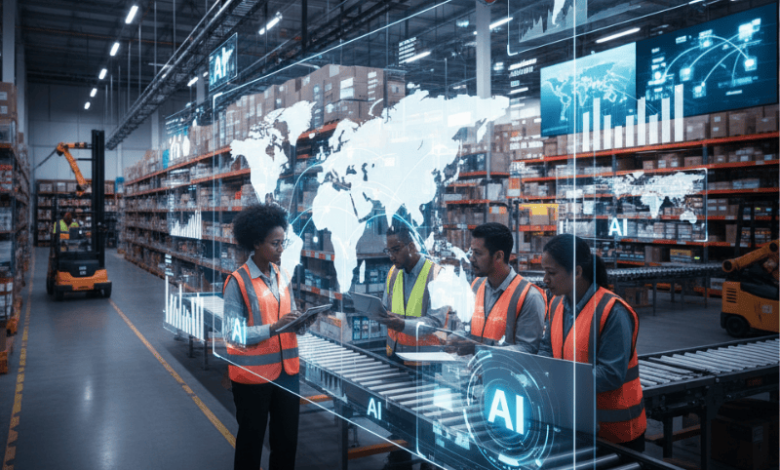
The Pressure on Today’s Supply Chain of Retailing
Merchants today are operating in one of the most volatile environments in recent years. Inflation, shifting consumer demand, and global disruptions, ranging from supply shortages to extreme weather, have exposed vulnerabilities in supply chains worldwide.
Retailers have much at stake. They expect products to be available where and when the customer wants them. They expect the correct pricing, timely offers, and a convenient in-store experience. When supply chains malfunction, shelves become bare, and customer-facing technologies annoy rather than exhilarate.
The question is no longer whether retailers should innovate in supply chain management; it’s how fast they can leverage new tools to build resilience. Increasingly, the answer lies in a strategic application of artificial intelligence (AI).
How AI is Redefining the Law of Retail
Artificial intelligence is transforming the supply system from a reactive to a predictive and adaptable network. No longer is it based solely on past data; now, with the use of real-time signals, it is possible to optimize demand forecasting, logistics, and waste reduction.
You can integrate external variables, including weather predictions, local events, macroeconomic indicators, and even Twitter trends. You end up with a dynamic forecast for demand.
This translates for retailers into fewer stockouts, fewer overstocks, and greater alignment with actual customer behavior. In commodity segments such as fresh food, the effect is quantifiable. Research from McKinsey demonstrates that AI-based forecasting can reduce waste by up to 20% while increasing on-shelf availability.
AI also optimizes routes in real-time based on traffic flows and fuel prices, thereby reducing transportation expenses. This is especially crucial, given that last-mile delivery costs are among the most significant pressures on margins. Deloitte notes that as companies utilize AI for logistics, they can reduce expenses by 15% while enhancing their service levels by more than 60%.
By identifying patterns of overstocks, AI also suggests changes that trim waste directly and benefit sustainability objectives.
Implementation Path: An Issue That Transcends Technology
Where the advantages are apparent, the journey to such a rethinking isn’t smooth. Successful AI adoption is about far more than acquiring software; it demands a careful transformation that moves beyond core difficulties.
- Data quality: An AI is as reliable as the data it is trained on, but most organisations wrestle with data dispersed throughout heterogeneous systems. Synchronizing and cleaning such data with a single source of truth is usually the first and most challenging step.
- Investment in people and infrastructure: Deploying AI systems requires upfront investment in technology, cloud infrastructure, and, most importantly, skilled personnel. It must be viewed not as a one-time cost, but as an investment in future competitiveness.
- Cultural adoption: The outcome shift is not brought about solely by technology. Upskilling the current team and reinforcing belief in the AI system is key. Change resistance may freeze an otherwise advanced solution.
From Back-End Operations To The Customer’s Hands
It is possible to regard supply chain innovation as an after-the-fact back-office activity; yet, what it provides directly is an immediate and profound impact on customer experience.
When supply data is imprecise, it is immediately apparent at the customer interface. An out-of-stock product is posted on a self-service screen, or a price check reveals an outmoded price.
I witnessed it first-hand after implementing self-service and signage systems. Customers would scan an item and find it was not actually on the shelf. It was not the frustration with the kiosk; it was being out of sync with the in-store availability.
AI resolves the issue by integrating supply chain data with customer-end systems, ensuring a consistent and similar experience across POS, kiosks, and digital signage.
Real-World Cues and An Equilibrium Perspective on Risks
Future supply chains with artificial intelligence are not fiction; they are reality. Large retailers are already seeing returns:
- US grocery store chains achieved over 80% forecast accuracy with the introduction of machine learning models, compared to ~60% with conventional techniques.
- European fast fashion merchants refined their replenishment cycles using AI and reduced markdowns by up to 15%.
- Consumer goods businesses are exploring AI-driven “control towers” that exercise end-to-end, real-time transparency across their networks.
But one needs to stay balanced:
- Algorithmic bias: If AI is trained using defective historical data, it may reinforce errors.
- Over-reliance on “black box” models: There is a need for retailers to maintain human intervention and overriding of AI-based decisions.
- Cybersecurity: Centralizing key customer and business information necessitates a robust “security by design” strategy.
Getting Started: Early Steps Toward an AI-Driven Supply Chain
Where do merchants even start? It is not with a “big bang” strategy. It is with a slow, selective one.
- Begin with a plausible business challenge: for example, “What are some ways we might decrease fresh food losses by 10%?” This sets a numerical objective.
- Pilot project introduction: Select one kind of product or one region and pilot the technology. Utilize it as a means of gaining confidence and refining your model.
- Create a cross-functional team: AI projects will never exist in silos. You need operations, technology, merchandising, and finance from the very beginning.
Conclusion
Traders who are open to using AI in supply chains are not merely streamlining operations but redesigning the very foundation upon which customer trust is based. From forecasting to store accuracy, AI is building a new benchmark of hardiness and dependability.
Success, however, won’t arise out of blind adoption. It will arise from a systemic strategy that acknowledges both the vast potential and the practical considerations of execution. Those leaders who lead this reinvention thoughtfully will be best prepared for disruption, customer loyalty, and prosperity in the next phase of the store.




